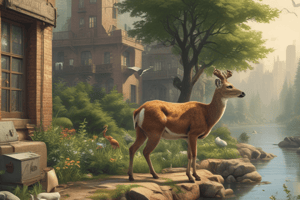Podcast
Questions and Answers
What role do many wildlife species play in relation to environmental changes?
What role do many wildlife species play in relation to environmental changes?
- They serve as indicators of environmental change and ecosystem health. (correct)
- They have no significant role in indicating environmental changes.
- They are recreational resources for tourism.
- They are sources of food for humans.
Intrinsic value refers to the utility of wildlife to humans.
Intrinsic value refers to the utility of wildlife to humans.
False (B)
Name a primary benefit of biodiversity preservation.
Name a primary benefit of biodiversity preservation.
Resilience against environmental changes.
Protecting wildlife is crucial for maintaining __________ health and resilience.
Protecting wildlife is crucial for maintaining __________ health and resilience.
Which of the following is NOT a reason for wildlife conservation?
Which of the following is NOT a reason for wildlife conservation?
Match the wildlife values with their descriptions:
Match the wildlife values with their descriptions:
Wildlife conservation can help mitigate climate change effects.
Wildlife conservation can help mitigate climate change effects.
What is one major threat that underscores the need for urgent wildlife conservation?
What is one major threat that underscores the need for urgent wildlife conservation?
Which of the following is NOT considered a form of wildlife?
Which of the following is NOT considered a form of wildlife?
Wildlife contributes to biodiversity, which is essential for ecosystem stability.
Wildlife contributes to biodiversity, which is essential for ecosystem stability.
Name one ecological value of wildlife.
Name one ecological value of wildlife.
Wildlife plays a vital role in _________, seed dispersal, nutrient cycling, and pest control.
Wildlife plays a vital role in _________, seed dispersal, nutrient cycling, and pest control.
What is one economic benefit of wildlife?
What is one economic benefit of wildlife?
Match the following values of wildlife with their descriptions:
Match the following values of wildlife with their descriptions:
How does wildlife support cultural value?
How does wildlife support cultural value?
All wildlife species are harmful to the ecosystem.
All wildlife species are harmful to the ecosystem.
Flashcards are hidden until you start studying
Study Notes
Wildlife Overview
- Wildlife encompasses all non-domesticated plants, animals, and organisms that exist naturally without human introduction.
- Plays a critical role in maintaining environmental balance and ecosystem health.
Examples of Wildlife
- Examples include lions, elephants, various bird species (animals), wildflowers, and trees (plants), and mushrooms and molds (fungi).
Values of Wildlife
- Ecological Value: Vital for biodiversity, ecosystem stability, and resilience, supporting essential ecosystem services.
- Economic Value: Generative influence on ecotourism, local economies, and providing resources such as food and medicine.
- Cultural Value: Integral to cultural heritage, traditions, and spiritual practices of many communities, enriching human experiences.
- Scientific Value: Aids in research and education, serving as biological indicators of environmental health.
- Intrinsic Value: Ethical perspective that wildlife has a right to exist independently, enhancing the beauty of natural landscapes.
Conservation Importance
- Ecosystem Health: Key to maintaining balance and stability in ecosystems; conservation programs protect critical habitats.
- Climate Change Mitigation: Diverse wildlife habitats contribute to carbon sequestration and lessening climate impacts.
- Biodiversity Preservation: Ensures survival of various species, critical for resilience against environmental changes.
- Sustainable Coexistence: Education focuses on living sustainably alongside wildlife, reducing negative impacts on habitats.
- Future Generations: Conservation prioritizes the enjoyment and appreciation of nature for future generations, countering threats like poaching and pollution.
Studying That Suits You
Use AI to generate personalized quizzes and flashcards to suit your learning preferences.




